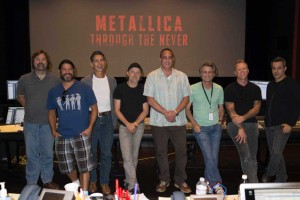
Haboush, Mark Mangini, James Hetfield and Greg Fidelman.
Joe Hutshing edited the music-driven film written to take an audience through both the band’s carefully selected set-list and Trip’s narrative journey. Trip, a stagehand for Metallica, is asked to fulfill a task which takes him away from the arena and into a city ripe with riot and destruction, unknown to Trip. Hutshing sews the two unfolding stories together using the band’s music as a motivating thread for transition points. The set-list was planned and explored throughout postproduction to be the voice of Trip who never speaks during the film. “You can argue that the music is the dialogue,” expressed Ulrich.
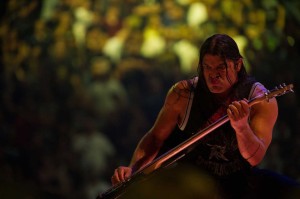
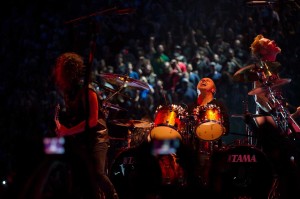 Trip’s story was cut entirely before concert footage was looked at. “I cut the part with Dane Dehaan first as if it was it’s own movie. It was about 25 minutes,” said Hutshing. According to Hutshing, the biggest challenge of intercutting the concert footage with the narrative was deciding which moments of each song would propel Trip’s story forward, and on returning to concert footage from the narrative, would accentuate the moment within the song being played. The order of songs played during shooting “had to be switched around a bit to cater to the movie. The most important thing was to get the flow right for the film,” explained Trujillo.
Trip’s story was cut entirely before concert footage was looked at. “I cut the part with Dane Dehaan first as if it was it’s own movie. It was about 25 minutes,” said Hutshing. According to Hutshing, the biggest challenge of intercutting the concert footage with the narrative was deciding which moments of each song would propel Trip’s story forward, and on returning to concert footage from the narrative, would accentuate the moment within the song being played. The order of songs played during shooting “had to be switched around a bit to cater to the movie. The most important thing was to get the flow right for the film,” explained Trujillo.
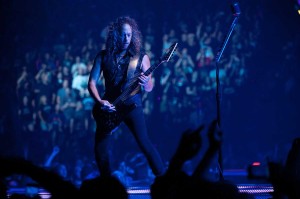 Sound mixer Jeffrey Haboush, music producer Greg Fidelman and sound designer Mark Mangini were tasked with sweetening the soundscape for the stage that features pyrotechnic effects, hydraulic lighting towers and a giant statue faked as marble that, at one point in the show, crumbles to the stage. Providing sound effects for these active elements required satisfying the narrative film aspect while never imposing on the band’s music. Recalling one particular edit in the soundtrack, Mangini said, “That statue was not made out of marble, but we had to make it sound like it was. We introduced rock sounds for the statue when it fell apart and with the first pass Jeff thought the rock-falls were too immense. They shook the theater. I think Greg’s words to me were ‘Mark, nothing can be louder than Lars’ kick drum.'” Additionally, Mangini noted, “Anything we do in the sound effects realm, anything not what the band is doing, has to work musically and rhythmically.”
Sound mixer Jeffrey Haboush, music producer Greg Fidelman and sound designer Mark Mangini were tasked with sweetening the soundscape for the stage that features pyrotechnic effects, hydraulic lighting towers and a giant statue faked as marble that, at one point in the show, crumbles to the stage. Providing sound effects for these active elements required satisfying the narrative film aspect while never imposing on the band’s music. Recalling one particular edit in the soundtrack, Mangini said, “That statue was not made out of marble, but we had to make it sound like it was. We introduced rock sounds for the statue when it fell apart and with the first pass Jeff thought the rock-falls were too immense. They shook the theater. I think Greg’s words to me were ‘Mark, nothing can be louder than Lars’ kick drum.'” Additionally, Mangini noted, “Anything we do in the sound effects realm, anything not what the band is doing, has to work musically and rhythmically.”
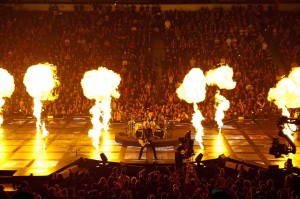 An additional sound mixing challenge was discovered when considering each musician’s proximity to camera during each shot. “The instincts of the band and myself, coming from the music world, is if you’re looking at the bass player, the bass doesn’t get louder. To the guys in the film world, if the guy is up close he’s louder. It took us a little while to figure out how that dance actually worked,” said Fidelman.
An additional sound mixing challenge was discovered when considering each musician’s proximity to camera during each shot. “The instincts of the band and myself, coming from the music world, is if you’re looking at the bass player, the bass doesn’t get louder. To the guys in the film world, if the guy is up close he’s louder. It took us a little while to figure out how that dance actually worked,” said Fidelman.
Before moving the stage to Canada for the filmed concerts, the band spent time adjusting to its unparalleled size in Mexico City, performing 10 concerts in a two week span. “The stage is very dangerous. We needed to learn how to navigate that thing,” said Trujillo. “With time you learn where not to be. We had to put big fluorescent pieces of tape down that said ‘do not stand here during Fuel. You will die’ because of all the explosions.”
Metallica Through The Never releases on DVD, Blu-Ray, 3D Blu-Ray, digitally and VOD Jan. 28.
For more, see Nimród Antal Brings Metallica to the MAX.





